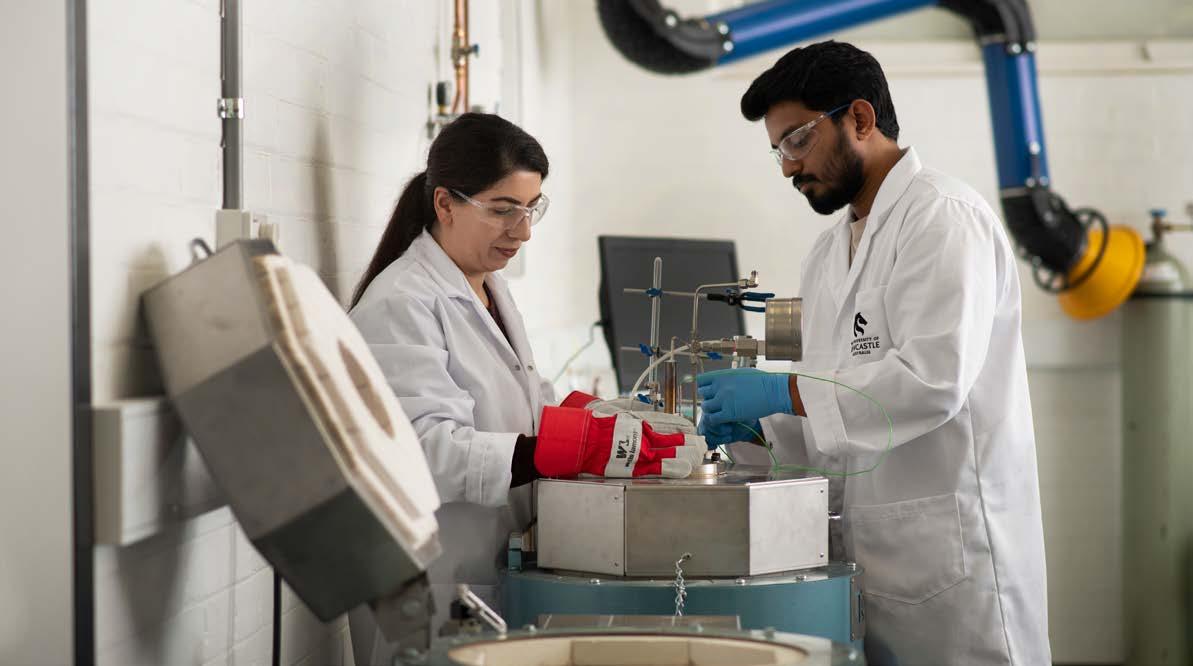
4 minute read
INNOVATIVE SOLUTIONS
22
INNOVATIVE SOLUTIONS
NIER drives technology transfer and impact at scale to improve social, economic and environmental outcomes for sectors of global significance.
NEW METHODS TO CAPTURE EMISSIONS FROM INDUSTRIAL PROCESSES
Dr Jessica Allen from the Priority Research Centre for Frontier Energy Technologies and Utilisation is uncovering solutions to significant energy challenges facing society. Supported through an Australian Research Council Discovery Early Research Award (DECRA) Fellowship, Jessica is developing a new method to effectively capture the carbon dioxide from industrial processes such as cement, ammonia and steelmaking, and using renewable solar thermal energy inputs to turn the CO² into a stable carbon product.
The hard carbon by-product of this process is a major component in next generation batteries and is typically generated from coal-based materials. This innovative new system for drawing CO² down into a solid carbon product has the potential to turn emissions from heavy industry into a valuable export. Jessica intends to see this early stage technology under development at NIER through to a commercial outcome.
23
RAIL RUNNING CONVEYOR PROVES ADAPTABLE SYSTEM FOR BULK MATERIALS TRANSPORT
Developed in a collaboration between TUNRA Bulk Solids, the Centre for Bulk Solids and Particulate Technologies and Thyssenkrupp, Professor Craig Wheeler’s Rail Running Conveyor (RRC) represents a new, ultra-efficient, adaptable system for bulk material transport, with the efficiency of railway haulage but at much lower cost. Crucially, the RRC technology eliminates most frictional losses of conventional belt conveyors, which can contribute about 80 per cent of power and tension on long overland routes. RRC's effectively merge two proven technologies – heavy rail and overland belt conveying, and through efficiencies, bring lower Capital Expenditure and Operational Expenses. Additionally, RRC's offer significant advantages including the elimination of idler-related maintenance costs, higher running speeds with lower tensions, and greater curvability. More recently, the research team has developed a pipe conveyor variant of the RRC technology leading to significant energy and cost savings over the traditional pipe conveyor technology. Thyssenkrupp will soon partner with a top-10 global copper mining company to build two full-scale RRC systems, each 3km long, the first of their kind in the world. As a new technology being applied for the first time, both will be built as hybrids bringing significant power savings and capacity that can be quickly retrofitted back to conventional conveyors, covering any potential risk to the client.
REFLUX FLOTATION CELL AIDS VALUABLE MINERAL RECOVERY
Flotation is a prominent technique to recover and concentrate valuable minerals for making metals. Laureate Professor Kevin Galvin, Director of the ARC Centre of Excellence for Enabling Eco-Efficient Beneficiation of Minerals, invented the Reflux Flotation Cell (RFC) in 2011 to address the problems that existed with flotation, improving the process by promoting much faster separation and cleaner product. The technology formed part of the R&D partnership with Ludowici and in turn FLSmidth for the Reflux Classifier that began in 2002, and has since been proven to work at full-scale at a mine-site facility. The project cost $4.5 million and consisted of a sixparty industry consortium funded in part by the Department of Industry’s Global Innovation Linkage scheme and the Australian Coal Industry’s Research Program. The RFC design will allow for much higher throughputs and a broader particle size distribution and recovery of finer particles, ideal for a broad range of critical minerals. A new RFC Upscaling project aims to extend the commercialisation of the technology, as a new product of FLSmidth, into copper and iron ore. The project has a group of global partners supporting the implementation of the technology. Multiple pilot plants and global fields trials are now underway.
CHARGE AROUND AUSTRALIA PROJECT HIGHLIGHTS PRINTED SOLAR CELL TECHNOLOGY CAPABILITIES
When Professor Paul Dastoor and his team at the Priority Research Centre for Organic Electronics first created their light weight, low cost, printed solar panels, they knew the technology would make global impact in the energy market. A partnership between Charging Around Britain Ltd and the University of Newcastle is demonstrating the potential for these plastic cells, known as Organic Photovoltaics to revolutionise travel with the Charge Around Australia Project. The increasing popularity of electric vehicles has been vital in reducing emissions, but a lack of access to charging networks can cause challenges when it comes to driving longer distances. The project will highlight how solar energy can address this issue. By having a team drive around the entire coastline of Australia (over 15,000 kilometres) with a supply of the thin plastic solar cells, they will be able to roll them out in even the most remote regions to absorb solar energy when the car requires charging, creating their own portable power generators. This will demonstrate the viability and advantages of printed solar in remote locations. The technology involves the creation of polymer based inks, which will then allow for high-speed printing to fabricate large areas, using roll to roll processing techniques. The printed solar modules produced are low-cost, lightweight, and easy to install, making them a more accessible alternative to the silicon-based solar panels we have today. The 12-month project includes the design and development of a custom electric vehicle charging system for printed solar modules, manufacture and characterisation of the printed solar modules, and an associated STEM outreach program that will be delivered in schools on the route. The trip will truly test the usability of the Centre’s technology.






